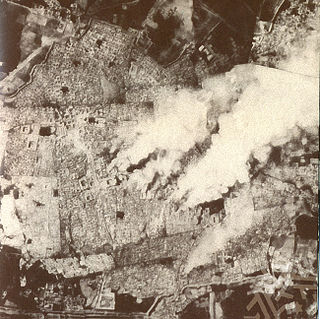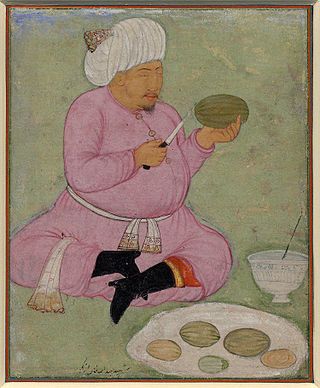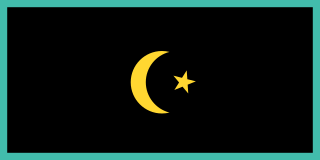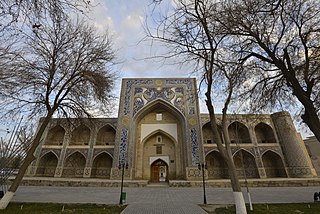
Uzbekistan is a landlocked country in Central Asia. It is itself surrounded by five landlocked countries: Kazakhstan to the north; Kyrgyzstan to the northeast; Tajikistan to the southeast; Afghanistan to the south, Turkmenistan to the south-west. Its capital and largest city is Tashkent. Uzbekistan is part of the Turkic languages world, as well as a member of the Organization of Turkic States. While the Uzbek language is the majority spoken language in Uzbekistan, Russian is widely used as an inter-ethnic tongue and in government. Islam is the majority religion in Uzbekistan, most Uzbeks being non-denominational Muslims. In ancient times it largely overlapped with the region known as Sogdia, and also with Bactria.

Khwarazm or Chorasmia is a large oasis region on the Amu Darya river delta in western Central Asia, bordered on the north by the (former) Aral Sea, on the east by the Kyzylkum Desert, on the south by the Karakum Desert, and on the west by the Ustyurt Plateau. It was the center of the Iranian Khwarezmian civilization, and a series of kingdoms such as the Afrighid dynasty and the Anushtegin dynasty, whose capitals were Kath, Gurganj and – from the 16th century on – Khiva. Today Khwarazm belongs partly to Uzbekistan and partly to Turkmenistan.

Khiva is a district-level city of approximately 93,000 people in Xorazm Region, Uzbekistan. According to archaeological data, the city was established around 1500 years ago. It is the former capital of Khwarezmia, the Khanate of Khiva, and the Khorezm People's Soviet Republic. Itchan Kala in Khiva was the first site in Uzbekistan to be inscribed on the World Heritage List (1991). The astronomer, historian and polymath, Al-Biruni was born in either Khiva or the nearby city of Kath.

The Basmachi movement was an uprising against Russian Imperial and Soviet rule in Central Asia by rebel groups inspired by Islamic beliefs.

The Khorezm People's Soviet Republic was the state created as the successor to the Khanate of Khiva in February 1920, when the Khan abdicated in response to pressure. It was officially declared by the First Khorezm Kurultay (Assembly) on 26 April 1920. On 20 October 1923, it was transformed into the Khorezm Socialist Soviet Republic.

Abdullah Khan (1533/4–1598), known as "The old Khan", was an Uzbek ruler of the Khanate of Bukhara (1500–1785). He was the last Shaybanid Khan of Bukhara from 1583 until his death.

The Khanate of Khiva was a Central Asian polity that existed in the historical region of Khwarezm in Central Asia from 1511 to 1920, except for a period of Afsharid occupation by Nader Shah between 1740 and 1746. Centred in the irrigated plains of the lower Amu Darya, south of the Aral Sea, with the capital in the city of Khiva. It covered present-day western Uzbekistan, southwestern Kazakhstan and much of Turkmenistan before the Russian arrival at the second half of the 19th century.

Lab-i Hauz, sometimes also known as Lyab-i Khauz, a Russian approximation, is the name of the area surrounding one of the few remaining hauz pools that have survived in the city of Bukhara, Uzbekistan. Until the Soviet period, there were many such pools, which were the city's principal source of water, but they were notorious for spreading disease and were mostly filled in during the 1920s and 1930s.

Uzbekistan Super League, known as Coca-Cola Uzbekistan Super League due to sponsorship reasons, is the top division of professional football in Uzbekistan. It is operated under the auspices of the Uzbekistan Professional Football League and Uzbekistan Football Association. It was founded in 1992 and currently has 14 teams. The top team qualifies to the group stage of the AFC Champions League.

Buddhism is practiced by about 0.2% of the population of Uzbekistan, according to the US State Department's International Religious Freedom Report 2004. Most are ethnic Koreans. Officially only one Buddhist denomination is registered in Uzbekistan, also there is a Buddhist temple in Tashkent.

The Chowdur or Choudor are one of the ten major groups of people who merged after 1920 to form the modern Turkmen Republic. They live primarily in and around the Khorezm Oasis.
Gurlan is a town and seat of Gurlan District in Xorazm Region in Uzbekistan. It is located near the border with Turkmenistan in western Uzbekistan, 42 kilometres (26 mi) north-west of Urgench, north of Shovot, and south of the Amu Darya river. Gurlen is a major centre for cotton production, and rice and yams are also significant other crops.
The 2013 Uzbekistan Cup was the 21st season of the annual Uzbek football Cup competition. The Cup draw was held on February 25, 2013 in Tashkent.

The Bukharan People's Soviet Republic was a Soviet state that governed the former Emirate of Bukhara during the years immediately following the Russian Revolution. In 1924, its name was changed to the Bukharan Socialist Soviet Republic. After the redrawing of regional borders, its territory was assigned mostly to the Uzbek SSR and some to the Turkmen SSR.

The flag of the Karakalpak Autonomous Soviet Socialist Republic was adopted in 1954 by the government of the Karakalpak Autonomous Soviet Socialist Republic. The flag is nearly identical to the flag of the Uzbek Soviet Socialist Republic. The former Karakalpak ASSR had its own flag from 1934 to its dissolution in 1992, which developed similarly to that of the Uzbek SSR. Basic design of the flag was always a red cloth with inscription.
The Khivan Revolution refers to the events of 1917–1924 in the Khanate of Khiva, which led to the liquidation of the Khanate in Khiva, the establishment of the Khorezm People's Soviet Republic, and the subsequent inclusion of the republic into the USSR through national disengagement and the formation of the Uzbek SSR and the Turkmen SSR in 1924.

Isfandiyar Khan, or Asfandiyar Khan, born Isfandiyar Jurji Bahadur, was the Khan of Khiva between September 1910 and 1 October 1918, the 53rd Khan of Khiva, and the 12th Khongirad ruler of the Uzbeks. He was overthrown and executed by Junaid Khan in 1918.

Seyid Islam Khodja was the Grand Vizier of the Khiva Khanate from 1898 until his death in 1913.
Bekjon Rakhmonov, known commonly as Mulla Bekjon, was an Uzbek and Soviet statesman, political and public figure, educator, linguist, polyglot, and journalist. He was one of the most prominent figures of the Khwarezmian Jadid movement and the Young Khivans.

Junaid Khan ; (b.1857/62–1938) was a Turkmen tribal leader who became the Chief of the Armed Forces and later the de facto and last ruler of the Khanate of Khiva.















